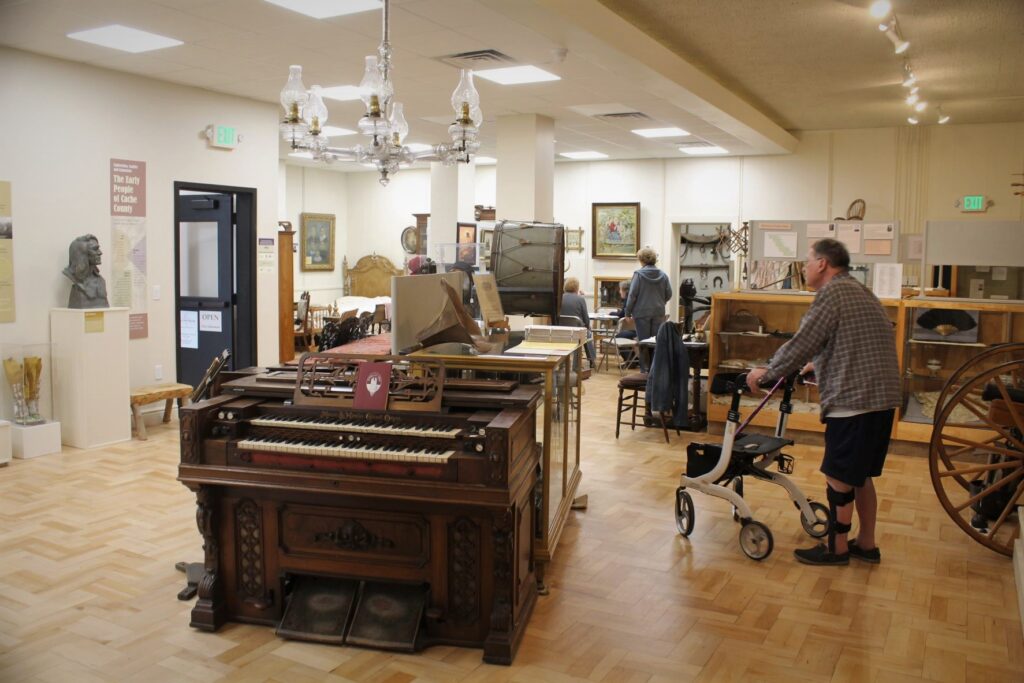Randy White of Hyrum looks at the relics at the Cache Daughters of Utah Pioneers on Wednesday March30, 2022.
LOGAN – The Cache Daughters of Utah Pioneers Museum, located at 106 Main Street, is finally open after two years of construction. They closed when Northern Title purchased the building and conducted some extensive remodeling of the building.
The building was built in 1911 as a Post Office and then added onto in 1933 when they added a courtroom. The museum is in the courtroom was par of the 1933 addition.

After several unexpected construction delays, they finally opened their doors to the public with a new entrance off Federal Avenue and an elevator for easy access to the old post office.
“We had a soft opening the first of March and have been training our DUP members on being docents,” said Sharon Johnson, the museum’s director. “We are now officially open for business on Wednesdays and Thursdays from 11 a.m. until 5 p.m. for regular business.”
They do, on occasion, schedule groups and appointments outside their regular hours.
The display area is lighter, more open and has brighter lighting. Gail Griswold, who specializes in museum displays, designed panels that give a history of the valley beginning with the Shoshone Native American tribes to the early days of Cache Valley.
There are stone grinders and gloves with bead work on display at the beginning as patrons come into the main area of the museum.
The Northwestern Band of Shoshone were known for their bead work.
“We didn’t have a large, single opening event due to managing traffic in our space. Please come on by and let people know we are ready for visitors,” Johnson said. “The entire building will have a grand event in June sometime, but we don’t want to wait for that.”

The local DUP Museum operates under the direction of the International Society of Utah Pioneers who’s purpose it is to honor the pioneers that came to Utah. They seek to honor the pioneers that settled Cache Valley before 1869.
The artifacts, histories and photos of early pioneers honor the legacy of the early settlers of Cache Valley. The photographic portraits on display and in the archives are an early window of prominent community members, business leaders, local government officials as well as members of The Church of Jesus Christ of Latter-day Saints.
Sharon Stevens, who manages the collections, said they are planning on having a rededication of the museum on April 27, at the same day they will rededicate a marker at the site of the old relic hall near Logan High School.
“We operate under the direction of the International Society of Utah Pioneers who’s purpose it is to honor the pioneers that came to Utah,” she said. “We want to honor the pioneers. We have collections of people who settled Cache Valley between 1820 and 1920.”
There is storage and archived photographs, quilts and furniture in the basement of the building carefully protected, using the most current archival methods. There is a digital copy of photographs and many documents that can be accessed online.

“The Utah Division of Arts & Museums pays a visit to the Cache DUP a couple of times a year,” Stevens said. “They evaluate our displays, archival methods and general practices to give encouragement and suggestions.”
There are also extensive personal and family histories written by the early settlers of the area. The histories cannot be reproduced, used for commercial gain on any digital format.
“The staff are all volunteers and the gift shop that once generated a small income for us is gone. There is no space for it,” Stevens said.
The pioneer organization has been housed with the same building since 1966.

